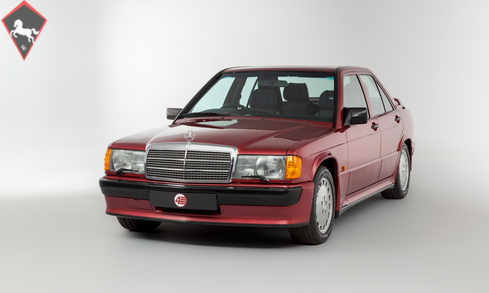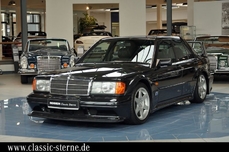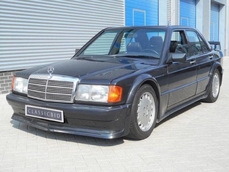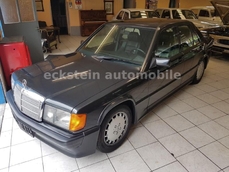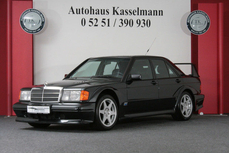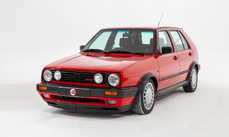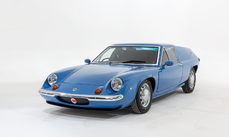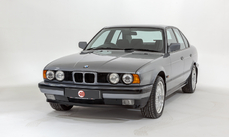Mercedes-Benz 190 2.5-16 2.5-16 Cosworth 1990
Allgemeine Beschreibung :
Model History
The Mercedes Benz 190 model name was first introduced in 1953 and has taken many different disguises until its final replacement in the form of the C series in 1993. The final incarnation of the 190 was the W201 chassis. £600 million was rumoured to have been spent developing the model, enough to have seriously damaged Mercedes-Benz reputation and financial position had the car been a failure. Luckily this was not the case and Mercedes went on to sell approximately 1.8 million units worldwide.
The introduction of the special edition 2.3-16v model in 1983 came from Mercedes-Benz's desire to re-enter motorsport with a direct factory team after their retirement following the tragic events at the 1955 Le Mans race. Enlisting the help of the British engineering firm Cosworth, Mercedes had plans to take the 190E to the rally circuit, however the project suddenly became unrealistic when Audi released the turbo charged, four-wheel drive Quattro, in effect beating the 190E before the race had even started! Mercedes not wanting to lose their financial investment in development ditched plans for the rally circuit and turned their attention to the German touring car championship.
The Cosworth engine was based on the 2.3-litre 8-valve already fitted to models in the range. Cosworth added an alloy head with twin overhead cams and 4 valves per cylinder boosting power to 185bhp and 174lb-ft. The car proved incredibly robust, with three cars only cosmetically altered completing a 50,000 km endurance test at the Nardo testing facility averaging 154.06mph and earning Mercedes three world records and nine international endurance records.
A larger 2.5-litre engine replaced the 2.3 in 1988. The 2.5 utilised a double valve timing chain to fix the problem of the single chains snapping on the 2.3. The increase in capacity took power to 204bhp in the non-catalyst car.
Both the 2.3 and 2.5 16v Cosworths featured a bodykit that reduced the drag coefficient to 0.32 one of the lowest figures for a four-door saloon at the time. The steering wheel was smaller and steering ratio quicker than other 190Es. The Getrag 5-speed manual ‘dogleg' box was standard, with the option of an automatic box along with a full leather interior. A limited slip differential was standard on the 2.3-16v, with the option of Mercedes ASD system that was standard fit on the 2.5-16v. ASD is an electronic system that hydraulically controls the amount of lock in the diff ranging from the standard 15% lock right up to 100%!
Equipment
Almandine Red Metallic paintwork, Half black leather/chequered cloth upholstery, 4-speed automatic transmission, 15-inch alloy wheels, Electric sunroof, Electric windows all round, electric passenger door mirror, Rear spoiler, Front air dam, Side skirts, Heated exterior mirrors, Heated washer nozzles, Leather steering wheel, Digital stopwatch, Rear armrest, Kenwood CD player with USB, Spare wheel, Spare keys, Mercedes fuel canister, Warning triangle, Original sales brochure, Original bill of sale.
Exterior
This cossetted 2.5-litre example presents beautifully in metallic Almandine Red. The paintwork boasts a lustrous shine all round having just been treated to a full detail and machine polish on arrival with us. The condition of the car is truly excellent throughout with no rust or blisters in any of the common W201 weak spots, the only negatives to report being a dusting of light frontal stone chips and two tiny marks on the driver’s side rear quarter. Having always been carefully stored away from the elements all the trims present in first-rate condition, and the underside is also remarkably clean. A best of breed example looking every bit the low mileage of just 68k.
VIEWINGS WELCOME BY APPOINTMENT ONLY /// ADDITIONAL PHOTOS AND VIDEOS AVAILABLE UPON REQUEST
Interior
A real treat for the enthusiast, the interior space is the finest we’ve seen of any 190E. The deeply bolstered sports seats are trimmed in the smart combination of black leather and chequered grey cloth, all in near-perfect condition with only the lightest of creasing to the driver’s side outer bolster. The rear seats are also immaculate and look as if they have been never sat in. The dashboard, centre console and wood trim are without any damage or marking, the switchgear still feels reassuringly solid to operate, and everything works exactly as it should. The carpets are spotless having always been protected by Mercedes overmats and, up above, the headlining is tight and mark-free. The boot area is also perfect and complete with the spare wheel, warning triangle, and Mercedes fuel canister. A well preserved and highly impressive interior, the only upgrade over standard being a Kenwood CD player with USB connectivity.
ENGINE & TRANSMISSION
Lifting the bonnet reveals an exceptionally clean and original engine bay. Often these cars suffer from cold start issues but with this example the 2.5-litre powerplant fires into life first turn of the key and ticks over smoothly. On the open road the auto ‘box changes smoothly with two program modes to suit the driver’s mood. The 16v engine pulls very well indeed, and inside the cabin there are no annoying squeaks or knocks to be heard. On arrival with us the car was fully inspected, MOT’d, and freshly serviced by our trusted classic car specialists, so she’s ready to be driven and enjoyed.
WHEELS, TYRES & BRAKES
Filling those boxy arches are the original 15-inch Mercedes alloy wheels, all in perfect condition having previously been refurbished to a very high standard. They are shod in a matching set of Avon tyres that have seen little more than 1k miles of use. On test the brakes feel capable and strong, stopping the car smoothly and in a straight line.
History File
This gleaming example was first registered in October 1990. Supplied new by Lancaster Mercedes-Benz of Hertford, the car remained under the same careful ownership until 2014. It was maintained religiously by Lancaster Mercedes until 51,527 miles before being retired to the South of France where it was tucked away in the first owner’s holiday home garage for a number of years. In early 2014 the car was brought out of dry storage and back to the UK; it was then fully recommissioned before finding a new home with its second owner.
The accompanying history file is complete with a raft of Mercedes and specialist invoices, old MOT certificates, original sales brochures, the original bill of sale from Lancaster Mercedes, and the service booklet which is stamped at the following mileages: 879 – 6,001 – 11,988 – 18,578 – 29,484 – 36,174 – 42,110 – 47,410 – 47,962 – 49,568 – 50,707 – 51,724 – 67,340 – 67,884 – 68,267 – and most recently at 68,510 in September 2022. The MOT is valid until September 2023 and the V5C shows 4 previous keepers (current since 2017).
http://www.4starclassics.com/for-sale/mercedes-190e-2-5-16-cosworth-for-sale/
1990 Mercedes-Benz 190 2.5-16 2.5-16 Cosworth is listed verkauft on ClassicDigest in Kingsley by 4 Star Classics for £29995.
Fakten der Auto
Karosserietyp : Auto Marke : Mercedes-Benz Modell : 190 2.5-16 Ausführung : 2.5-16 Cosworth Hubraum : 2.5 Modelljahr : 1990 Karosstyp : Pick up Lage : Hampshire
Verkauft
Angaben Zum Verkäufer
Verkauft
People who viewed this Mercedes-Benz 190 2.5-16 also viewed similar Mercedes-Benz listed at ClassicDigest
Other cars listed for sale by this dealer
über Mercedes-Benz
In den Annalen der Automobilgeschichte entfaltet sich die Reise von Mercedes-Benz wie eine Erzählung voller Ingeniosität seiner Gründer. Im Jahr 1886 schuf Karl Benz den Benz Patent Motorwagen, eine Kreation, die als das weltweit erste Automobil in die Geschichte eingehen sollte. Unwissentlich markierte dieser Moment den Ursprung dessen, was sich zu einem weltweit renommierten Premium-Autohersteller entwickeln würde. Die finanzielle Basis dieses bahnbrechenden Unternehmens wurde interessanterweise von Karls Ehefrau, Bertha Benz, bereitgestellt, was eine bemerkenswerte Partnerschaft demonstrierte, die den Ton für das Erbe von Mercedes-Benz setzen sollte.Nicht weit entfernt entstand eine parallele Erzählung, als die Daimler-Motoren-Gesellschaft, gegründet von Gottlieb Daimler und Wilhelm Maybach, die Bühne betrat. Im Jahr 1901 enthüllten sie ihr Auto unter dem mittlerweile berühmten Namen "Mercedes", was auf Spanisch "Geschenk Gottes" bedeutet. Dieser Name wurde auf das Auto auf Wunsch von Emil Jellineks Tochter verliehen, dem Vertriebspartner der Daimler-Motoren-Gesellschaft. Die Räder der Innovation wurden in Bewegung gesetzt.
Springen wir vorwärts ins Jahr 1926, ein entscheidendes Jahr, das die Fusion von Daimler mit Benz & Cie. sah, was zur Geburt von Daimler-Benz führte. Die Fusion führte zur Übernahme von "Mercedes-Benz" als das renommierte Markenzeichen für ihre Automobile und verschmolz die Legenden zweier visionärer Unternehmen zu einer.
Entgegen konservativen Wahrnehmungen entfaltet sich die Geschichte von Daimler-Benz als Chronik von Branchenneuheiten. Von der Einführung des Wabenkühlers über den Schwimmervergaser bis zur bahnbrechenden Einführung von Vierradbremsen im Jahr 1924 trieb Daimler-Benz kontinuierlich die Grenzen der automobilen Innovation voran. Der Dieselantrieb des Mercedes-Benz 260 D im Jahr 1936 markierte den Beginn von Dieselmotoren in Personenkraftwagen. Der ikonische Mercedes-Benz 300SL Gullwing schrieb Geschichte als das erste Auto mit direkter Kraftstoffeinspritzung, wenn auch der winzige 2-Takt-Motor des Gutbrod Vorrang beanspruchen kann.
Sicherheitsinnovationen wurden zum Markenzeichen, mit Béla Barényis patentiertem Sicherheitszellen-Design in den "Ponton"-Modellen im Jahr 1951, das Front- und Heck-Knautschzonen umfasste. Der W116 450SEL 6.9 führte die Einführung des Antiblockiersystems (ABS) ein, eine weitere wegweisende Sicherheitsfunktion. Vom ersten serienmäßigen Airbag bis hin zu vielen weiteren Innovationen wurde das Erbe der "Ersten" weiter in das Gewebe von Daimler-Benz eingeschrieben.
Auf seiner über hundertjährigen Reise hat Mercedes-Benz nicht nur Autos produziert, sondern automobile Ikonen geschaffen. Der SSKL, 710 SSK Trossi Roadster, 770K Grosser, 540K Spezial Roadster, 300SL Gullwing, W100 600 Pullman, W111 280SE 3.5 Flachkühler, W113 230SL Pagode, W109 300 SEL 6.3 und W201 2.3-16 Cosworth sind Zeugnisse des Engagements der Marke für Ingenieurkunst.
Die donnernden Silberpfeile, oder "Silberpfeile", darunter der W 25, W 125, W154, W165 und W196, schufen ein Erbe der Dominanz auf der Rennstrecke. Diese Maschinen waren nicht nur Autos; sie waren Ausdruck von Präzision, Geschwindigkeit und einem unbezwingbaren Geist, der die Konkurrenz im Staub zurückließ.
Während Mercedes-Benz in die Zukunft schreitet, tut es dies nicht nur als Automobilhersteller, sondern als Hüter eines Erbes, als Fackelträger der Innovation und als Leuchtturm automobiler Exzellenz. Der Weg in die Zukunft wird zweifellos die Fortsetzung der Verschmelzung von modernster Technologie, zeitlosem Design und dem unerschütterlichen Engagement für die Festlegung neuer Standards in der Welt der Automobile erleben.
